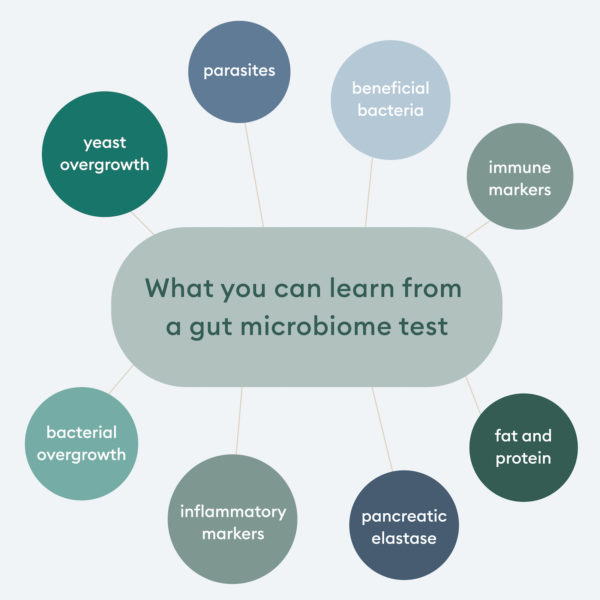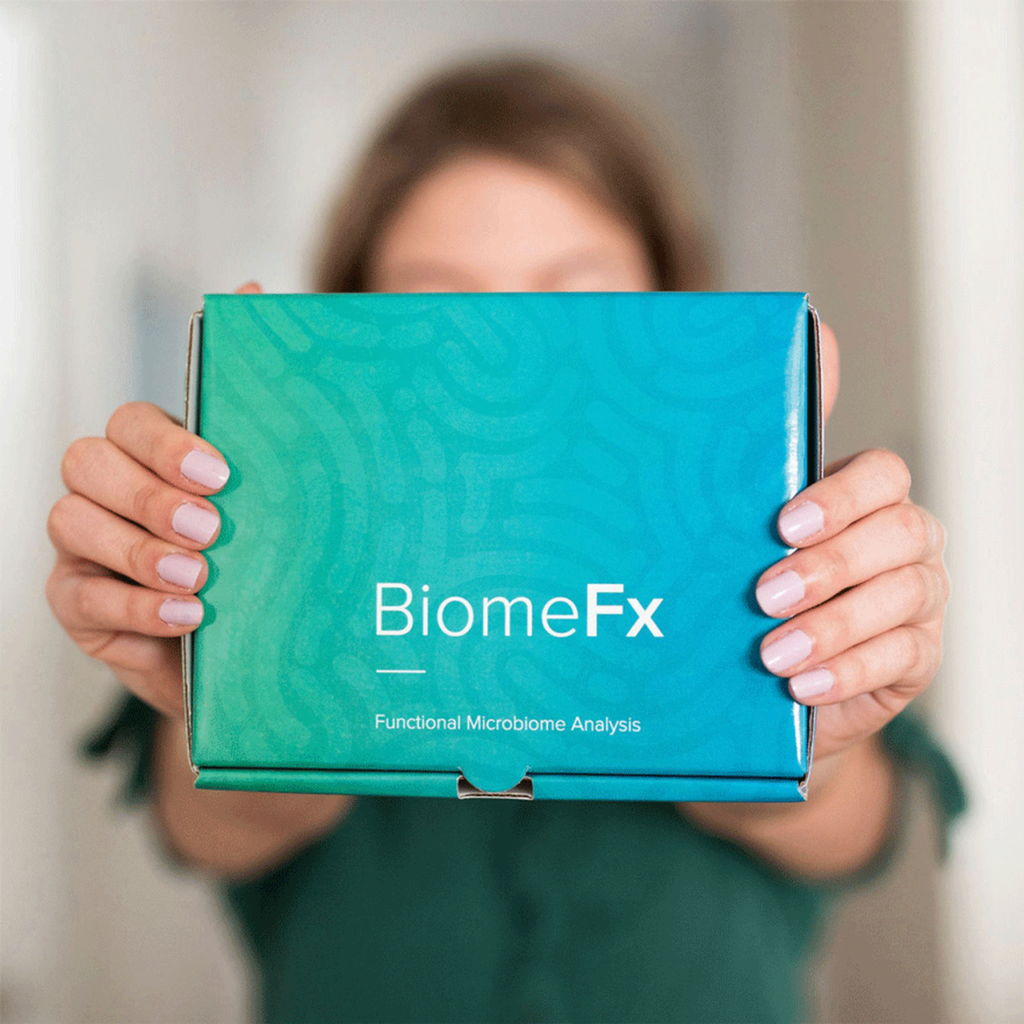Last updated on March 5th, 2022 at 08:22 pm
Gut Microbiome Testing: What is it and should you get it?
What is a microbiome?
James Harrington once said “Measurement is the first step that leads to control and eventually to improvement. If you can’t measure something, you can’t understand it. If you can’t understand it, you can’t control it and if you can’t control it, you can’t improve it.”
Your gut health and microbiome may seem like a big mystery. A person’s microbiome is a genetic snapshot of all the microscopic organisms in their body. Think about it like a community of bacteria, archaea, fungi, as well as viruses. When the community is working well together you may be healthy and feeling good. When the community is not working well together or is out of balance many times you feel awful. The good news is we can measure and test our gut microbiome to learn what we may need to improve or change.
What is gut microbiome testing?

Gut Microbiome testing looks at the good and bad bacteria in your gut. You may be taking Probiotics already to try and improve the good bacteria in your gut. The tests also look for how your digestive tract is working. Signs of pathogens, immune or inflammatory markers can indicate potential problems. Microbiome tests are a bit more involved as they usually require you to take a sample of your poop. Yuck, that sounds disgusting right, but if you think about it there isn’t a more effective way. The sample goes in a container that’s mailed into a lab. The benefit of this method is you get to do it in the privacy of your own home which beats the doctor’s office.
How Does a Gut Microbiome Test Work?
Tests are done by collecting a stool sample and having it analyzed. The key to success is having it analyzed in a way that the results are accurate and meaningful.
One specific testing method used is called ’16s RNS ribosomal sequencing’, or 16S for short. In simple terms, this technique isolates the microbial DNA from the various micro-organisms present in the provided stool sample. The analysis shows which microbes are dominant in the gut.
The bad news with this approach is that it has less than 50% accuracy in identifying microbial species. It offers insight into phyla and genera, but due to its use of low-resolution images, it does not offer enough precise detail about bacteria at the species level. The species data is very important! For example, the bacteria Escheria coli has many strains. Some of these are pathogenic, while other strains of E. coli are protective. Furthermore, 16S is unable to distinguish between living or dead cells and it can’t offer insight into their metabolic activity.
The most effective test for the microbiome is a whole genome sequencing test. A recent study found that whole-genome sequencing identified nearly twice as many bacterial species compared to 16S methods, providing more information on microbial richness and diversity (4). This is a stunning finding as individuals using 16S methods may receive faulty dietary and lifestyle advice in response to these testing methods. Whole-genome sequencing is far superior and allows clinicians to more accurately provide interventions to heal and balance the gut.
How do I get my gut microbiome tested?

There are many different types of gut microbiome tests on the market. Many of them can only be ordered by healthcare professionals. There are a few however that can be ordered directly by consumers.
One of the best testing kits we’ve found is the BiomeFx kit as it features full genome sequencing which provides the most accurate results. Many kits have you scrape the top of a piece of stool and send it in. BiomeFx provides a coring tool that takes samples throughout the stool’s layers. This provides a more accurate sample. The lab provides state-of-the-art genomic sequencing technology that accurately identifies exactly what’s in your microbiome. The report then shows you how your sample compares to a healthy sample and the service is offered with a healthcare practitioner who can provide guidance and suggestions on how to improve your gut health.
Testing kits typically consist of a swab or sample collection ‘probe’ and a collection vessel (with added agents to preserve the sample during shipping) into which a small sample of feces needs to be placed. Testing companies that sell direct to consumers have a customer care team to help interpret the test results once they have been given and some offer a full plan which includes probiotics, dietary advice, and a follow-up test.
What can you learn from a gut microbiome test?
The digestive system is an extremely complex part of the body, so these tests are not your typical lab tests that check a handful of biomarkers. Depending on the exact test used it will look for all sorts of different organisms including bacteria, parasites, and much more. These things are found by the presence of their DNA. You might be surprised but parasites are more common than you think. Common infections include Blastocystis hominis and Dientamoeba fragilis, which cause symptoms like nausea and stomach pain.
You’ll learn what is present in your microbiome and based on that how dietary changes, supplements, or medications may help alleviate whatever symptoms you are having. Here are a few things that you may find based on the test:
Yeast overgrowth
Too much yeast, like the common yeast called Candida albicans, can explain a wide range of GI symptoms. It may contribute to other symptoms like acne, weight gain, and brain fog. When Candida begins to grow uncontrollably, it can cause an infection known as candidiasis. Candida is the most common cause of fungal infections in humans
Bacterial overgrowth
This includes both “potentially pathogenic” and pathogenic bacteria. A “potentially pathogenic” bacteria is a type of bacteria that only becomes pathogenic if it’s allowed to overgrow. In other words, a small number of these bacteria won’t cause symptoms but a large number might. In contrast, pathogenic bacteria like salmonella or certain strains of e-coli are harmful at pretty much any number.
Calprotectin
Calprotectin is an inflammatory marker associated with irritable bowel disease and tumors. If your levels are significantly elevated, you’d need to consult a GI specialist about the next steps.
Immune markers
Testing for immune markers helps reveal whether the immune system is over-or under-active. Specific inflammatory markers, such as IgA, point to a food sensitivity or something else in the GI tract—like a fungus or bacteria—that’s triggering an immune response. Elevated levels of eosinophils indicate an allergy or a parasite.
Pancreatic elastase
Pancreatic elastase is an enzyme that you should have appropriate amounts of; if not, your pancreas might not be functioning well and as a result, you might not be breaking down your food effectively.
Fat and protein
By testing for the presence of protein and fat in the stool, your doctor can tell how well you’re digesting and absorbing your food.
Beneficial bacteria
Finally, these microbiome tests also look for the good stuff. Most tests look for short-chain fatty acids (like butyrate) that should be in your colon and stool in high quantities if you have a vast, robust microbiome. If you’re not eating enough fiber or breaking down the fiber appropriately, these bacteria might be missing.

Who should get a gut microbiome test?
- Anyone who has GI issues, who has had GI issues for a long time, or who has an autoimmune disorder.
- Stool testing is also important for skin diseases.
How do I fix my microbiome?
Every person’s microbiome is different and may have different problems. These problems can be complicated by your medical history or other conditions. You should work with a healthcare professional to find out how to fix your microbiome. There are a wide range of issues for example not digesting your food properly. This could be an issue where you have a gluten intolerance where something like Wheat Rescue may help. It could also mean an enzyme such as FODMate or a low FODMap diet could help.
On the other hand, it could be a disease such as ulcerative colitis, part of the Irritable Bowel Syndrome family. It’s important to know what you’re working with in order to know the right steps to take.
If you are going to move forward you may want to start with some basic steps like removing toxins using natural immunoglobulins and replenishing good bacteria via probiotics. Again, please make sure you consult your healthcare practitioner to find out what’s right for you before starting any supplements or regimens.
How much does microbiome testing cost?
Different microbiome testing kits can range from $150 to well over $1,000. Lower cost kits may not provide the necessary information to interpret the reports and make the right decisions on how to improve your gut health. Like many things in life, you get what you pay for. The key is to get a test that uses the full genome sequencing approach. It’s also very helpful to have a healthcare professional walk you through the results so they can provide suggestions on the next steps to take. The microbiome is a complicated system and making the right dietary and nutritional changes can greatly benefit you. Conversely doing the wrong things can cause harm.
Is microbiome testing covered by insurance?
Microbiome testing may be covered by insurance if you go through your primary care doctor to do it and it’s approved by your insurance. Most tests are not covered by insurance but you may be able to use your Health Savings Account (HSA).
Microbiome Testing Frequently Asked Questions
What causes bad gut bacteria?
Diet and lifestyle factors, including poor sleep quality, alcohol consumption, and inactivity, can harm your gut bacteria. Your body may not digest food properly in the stomach. This could be because you don’t have strong enough stomach acid. This can lead to bad bacteria overgrowth in the small intestine. If the small intestine doesn’t move food through at a fast enough pace that can also lead to bacterial overgrowth. It’s not always bad gut bacteria. You may unknowingly ingest pathogens from tainted food or from daily activities like swimming. There are many ways in which the microbiome in the gut can become out of balance.
How do I get rid of bad bacteria in the gut?
While some bacteria are bad news, most are not. Diversity and balance are the keys to gut health. If you do have more bad bacteria than you should there are quite a few ways to move back towards balance. The first thing that’s important to know is that it’s not always bad bacteria. It could be parasites, fungi, or other pathogens so a stool test can be a great start to figuring out what the problem is.
A good gut health test will show you which microbes have multiplied beyond healthy levels. If you already know that you have an imbalance and you want to try getting rid of it naturally a botanical blend may help. If the cause is specifically undigested food fermenting in the lower intestine a specialized digestive enzyme may help. You may need to increase stomach acid as well and MegaGuard is a great way to do that. Working with a healthcare practitioner is really important as there are a lot of complexities in the microbiome and you don’t want to make a situation or your health worse.
How can I get my gut bacteria tested?
You can get your gut bacteria microbiome tested by doing a stool test in the comfort of your home or at your healthcare practitioner’s office.
NOTHING IN THIS WEBSITE IS INTENDED AS OR SHOULD BE CONSTRUED AS, MEDICAL ADVICE. ANY HEALTHCARE AND/OR NUTRITIONAL MATERIAL CONTAINED IN THIS WEBSITE IS FOR CONSUMER INFORMATIONAL AND EDUCATIONAL PURPOSES ONLY. SUCH MATERIAL IS NOT INTENDED AS MEDICAL ADVICE FOR CONDITIONS OR TREATMENT, NOR IS IT INTENDED AS A SUBSTITUTE FOR A MEDICAL EXAMINATION BY A HEALTHCARE PROFESSIONAL. CONSUMERS SHOULD CONSULT THEIR OWN HEALTH CARE PROFESSIONALS FOR INDIVIDUAL MEDICAL RECOMMENDATIONS.
- Magnesium Threonate: An Honest Buying Guide for Health Enthusiasts - March 21, 2024
- Magnesium Citrate Vs Glycinate: 5 Key Differences And Benefits - March 14, 2024
- How to Pick the Best Magnesium Glycinate Supplement for You - March 7, 2024




